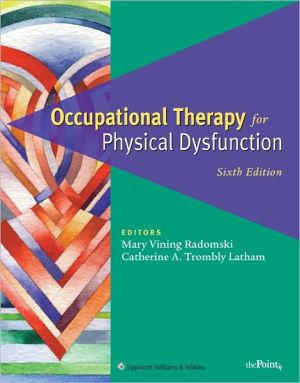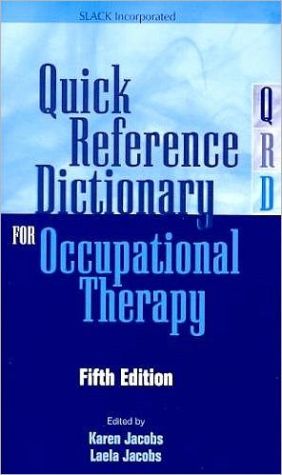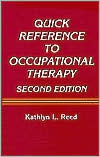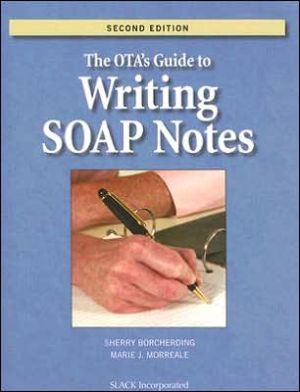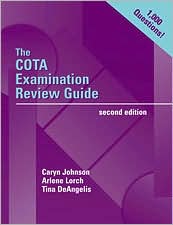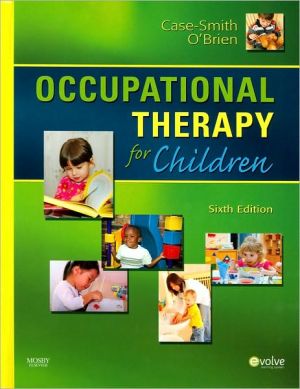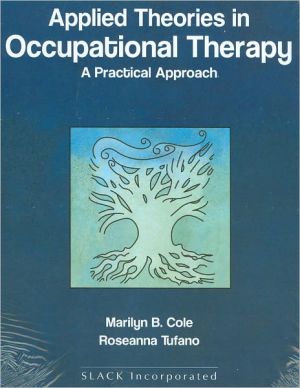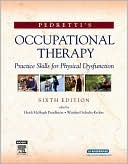Occupational Therapy for Physical Dysfunction: Comprehensive Atlas
The definitive work on occupational therapy for physical dysfunction returns in its Sixth Edition, with reputable co-editors and clinical, academic, and consumer contributors. This text provides a current and well-rounded view of the field- from theoretical rationale to evaluation, treatment, and follow-up. Through the Occupational Functioning Model (OFM), the Sixth Edition continues to emphasize the conceptual foundation and scientific basis for practice, including evidence to support the...
Search in google:
The definitive work on occupational therapy for physical dysfunction returns in its Sixth Edition, with reputable co-editors and clinical, academic, and consumer contributors. This text provides a current and well-rounded view of the field- from theoretical rationale to evaluation, treatment, and follow-up. Through the Occupational Functioning Model (OFM), the Sixth Edition continues to emphasize the conceptual foundation and scientific basis for practice, including evidence to support the selection of appropriate assessments and interventions.NEW TO THIS EDITION: Student DVD with video clips demonstrating range of motion, manual muscle testing, construction of hand splints, and transferring patients Evidence Tables summarize the evidence behind key topics and cover Intervention, Participants, Dosage, Type of Best Evidence, Level of Evidence, Benefit, Statistical Probability, and Reference Assessment Tables summarize key assessment tools and cover Instrument and Reference, Description, Time to Administer, Validity, Reliability, Sensitivity, and Strengths and Weaknesses Doody Review Services Reviewer:Christine S. Olson, MS, OTR/L(Rush University Medical Center)Description:This book outlines the foundational aspects of occupational therapy and describes the role of occupational therapists in the physical disability setting. It is organized around the Occupational Functioning Model and includes a diagram of the model to help readers understand and organize the content. This is an update of the fifth edition of 2002.Purpose:It is intended to help occupational therapy students and practitioners acquire the skills necessary to provide occupational therapy services and facilitate the development of the reflection process used in practice. The book is a valuable tool for individuals studying and practicing occupational therapy. Audience:Although written for students and practitioners specializing or interested in the physical disability setting, the book contains general, basic information that experienced or specialized occupational therapists may not find helpful.Features:The book does an excellent job covering many pertinent topics in the area of physical disability, including the history of occupational therapy, assessments used in this setting, a variety of treatment approaches, common diagnoses seen by occupational therapists, and the role occupational therapists play in assisting individuals with a physical disability become more independent. The detailed descriptions and pictures of manual muscle testing and range of motion are helpful, as are the many pictures that illustrate and clarify the text. Internet resources are listed throughout the book, providing useful, up-to-date information. Using the Occupational Functioning Model helps organize thoughts and provides an example of implementing a model.Assessment:This book has been useful to me as a student and as a new therapist. Compared to the fifth edition, this edition focuses more on evidence, which is important for the future of occupational therapy. Using teaching tools such as case studies, the book is also helpful in developing the reflective process used in occupational therapy. Reflections are a necessary component of occupational therapy practice because of the variety of people and situations occupational therapists encounter. This is a great addition to an occupational therapist's collection of resources.
SECTION I: OCCUPATIONAL FUNCTION: DEFINITION, PROCESS, AND HISTORY Chapter 1: Conceptual Foundations for Practice Chapter 2: Historical and Social Contexts for Practice Chapter 3: Planning, Guiding, and Documenting PracticeSECTION II: ASSESSMENT OF OCCUPATIONAL FUNCTION Chapter 4: Assessing Roles and Competence Chapter 5: Assessing Abilities and Capacities: Range of Motion, Strength, and Endurance Chapter 6: Assessing Abilities and Capacities: Motor Behavior Chapter 7: Assessing Abilities and Capacities: Sensation Chapter 8: Assessing Abilities and Capacities: Vision, Visual Perception, and Praxis Chapter 9: Assessing Abilities and Capacities: Cognition Chapter 10: Assessing Context: Personal, Social, and Cultural Chapter 11: Assessing Context: Home, Community, and Workplace AccessSECTION III: THERAPEUTIC MECHANISMS Chapter 12: Occupation: Philosophy and Concepts Chapter 13: Occupation as Therapy: Analysis, Selection, Gradation, Adaptation Chapter 14: Learning Chapter 15: Therapeutic RapportSECTION IV: THERAPEUTIC TECHNOLOGIES Chapter 16: Upper Extremity Orthoses Chapter 17: Construction of Hand Splints Chapter 18: Wheelchair Selection Chapter 19: High-Technology Adaptations to Compensate for Disability Chapter 20: Physical Agent ModalitiesSECTION V: TREATMENT OF OCCUPATIONAL FUNCTION Chapter 21: Optimizing Abilities and Capacities: Range of Motion, Strength, and Endurance Chapter 22: Optimizing Motor Behavior Using the Occupational Therapy Task Oriented Approach Chapter 23: Optimizing Motor Skills Using Task-Related Training Chapter 24: Optimizing Motor Behavior Using the Bobath Approach Chapter 25: Optimizing Motor Behavior Using the Brunnstrom Movement Therapy Approach Chapter 26: Managing Deficit of First-Level Motor Control Capacities Using Rood and Proprioceptive Neuromuscular Facilitation Techniques Chapter 27: Optimizing Sensory Abilities and Capacities Chapter 28: Optimizing Vision, Visual Perception, and Praxis Abilities Chapter 29: Optimizing Cognitive Abilities Chapter 30: Restoring the Role of Independent Person Chapter 31: Restoring Mobility Chapter 32: Restoring Competence for Homemaker and Parent Roles Chapter 33: Restoring Competence for the Worker Role Chapter 34: Restoring Competence in Leisure Pursuits Chapter 35: Optimizing Personal and Social Adaptation Chapter 36: Optimizing Access to Home, Community, and Work Environments Chapter 37: Preventing Occupational Dysfunction Secondary to AgingSECTION VI: TREATMENT TO PROMOTE OCCUPATIONAL FUNCTION FOR SELECTED DIAGNOSTIC CATEGORIES Chapter 38: Stroke Chapter 39: Traumatic Brain Injury Chapter 40: Neurodegenerative Diseases Chapter 41: Orthopaedic Conditions Chapter 42: Hand Impairments Chapter 43: Spinal Cord Injury Chapter 44: Rheumatoid Arthritis and Osteoarthritis Chapter 45: Burn Injuries Chapter 46: Amputations and Prosthetics Chapter 47: Cardiac and Pulmonary Diseases Chapter 48: Dysphagia Chapter 49: Human Immunodeficiency Virus Chapter 50: Oncology Index
\ From The CriticsReviewer: Christine S. Olson, MS, OTR/L(Rush University Medical Center)\ Description: This book outlines the foundational aspects of occupational therapy and describes the role of occupational therapists in the physical disability setting. It is organized around the Occupational Functioning Model and includes a diagram of the model to help readers understand and organize the content. This is an update of the fifth edition of 2002.\ Purpose: It is intended to help occupational therapy students and practitioners acquire the skills necessary to provide occupational therapy services and facilitate the development of the reflection process used in practice. The book is a valuable tool for individuals studying and practicing occupational therapy. \ Audience: Although written for students and practitioners specializing or interested in the physical disability setting, the book contains general, basic information that experienced or specialized occupational therapists may not find helpful.\ Features: The book does an excellent job covering many pertinent topics in the area of physical disability, including the history of occupational therapy, assessments used in this setting, a variety of treatment approaches, common diagnoses seen by occupational therapists, and the role occupational therapists play in assisting individuals with a physical disability become more independent. The detailed descriptions and pictures of manual muscle testing and range of motion are helpful, as are the many pictures that illustrate and clarify the text. Internet resources are listed throughout the book, providing useful, up-to-date information. Using the Occupational Functioning Model helps organize thoughts and provides an example of implementing a model.\ Assessment: This book has been useful to me as a student and as a new therapist. Compared to the fifth edition, this edition focuses more on evidence, which is important for the future of occupational therapy. Using teaching tools such as case studies, the book is also helpful in developing the reflective process used in occupational therapy. Reflections are a necessary component of occupational therapy practice because of the variety of people and situations occupational therapists encounter. This is a great addition to an occupational therapist's collection of resources.\ \
